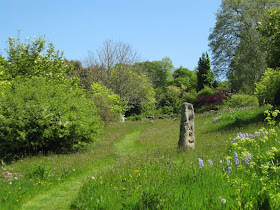




“New Naturalism”
Exquisite plantsmanship is the defining feature that sets the Garden House apart. In a country obsessed by flowers and gardening, that’s no mean feat (actually it’s quite extraordinary). This is a garden where you can truly get a taste of the English passion for plant cultivation, and what it can achieve when done well. But there's more than just good growing technique in this garden - the plants and plantings are somehow different, fresh and interesting. According to their own description, the Garden House is working on a different style of planting - the “New Naturalism”. The way I see it, New Naturalism à la Garden House means a combination of the traditional and modern. The garden is still designed to achieve the rather traditional goal of constant interest throughout the year, via a combination of all plant groups, including annuals, perennials, bulbs and shrubs. What's new is the style of the combinations and the plant species used. The combinations are mainly based on loose, natural weaving of plants, and the plants themselves include many new cultivars, some in the “new perennial” style, though certainly not restricted to that category.




While the plantings are absolutely fantastic, I did have one little criticism that I might as well put up front. The Garden House has amazing individual areas, but seems to lack a strong, overall structure. I don’t mean something formal, but something to give a sense of an overall, cohesive thesis. There is no frame to put around all the pretty plantings, to hang them together into one picture.
A tour around the garden
A great example of the “New Naturalism” style greets you as soon as you enter – the South African meadow garden, a relatively new addition and one of the current trends on the English gardening scene. This was one of the only areas which was actually not peaking at the time of our visit, but it still managed to be stimulating enough even in May. In this garden, the land was shaped to add interest to an otherwise flat area and to frame views. There are some great pictures on the website to show it at its peak.



The somewhat more traditional cottage garden follows in contrast to the South African meadow. The blooms were fantastic at the time we visited, and I'm sure it only gets better in the summer.



The cottage garden connects to the wildflower meadow, one of my favourite parts (surprise, surprise). The setting of the meadow is brilliant, with amazing views over both the wider landscape (complete with stone tower), and back towards the garden. It’s a low fertility meadow, mown once a year in early fall to allow for seeding of the native orchid Dactylorhiza praetermissa.


At the far side of the property, as you do a wide turn to continue on to the lower half of the garden, is the Acer glade. It’s stuffed full with Japanese maples, almost overwhelmingly so – it felt more like a collector's garden. But it’s hard not to admire these plants, especially the stunning specimen with salmon-pink leaves.



Low in the valley is the woodland section, which is filled with literally thousands of bulbs. We were lucky enough to come right during bluebell time. Pretty amazing.

The plantings in the lower bulb meadow just kept getting better and better. How could so many plants all be flowering in late May? These areas once again showcased the style of New Naturalism planting– complex, flowing tapestries of interwoven plants over large areas.




The walk around the garden continues on to the old walled garden and the ruins of the vicarage of Buckland Monachorum, the historic heart of the Garden House. Inside the walled garden, it was a bit surprising to find tulips in perfect bloom even at this late time.

And then it’s on to what I thought was the best part, although the pictures may not show it. From the walled garden which sits in the valley, you have to wind your way back up to the main house. This is done through a series of terraces, built up over several levels of old stone wall. The terraces are long and narrow, with a single file walkway in the middle. Each side of the walkway has been stuffed with absolutely amazing plantings - perennials, shrubs, lots of textures and some colour. I’m not sure if this was the original goal of the terraces, but the effect is that you are in a long, narrow passage enveloped by vegetation from both sides, with an occasional opening to the gardens and view below. A perfect combination of strong structure and soft plants, secret spaces and open views.




There was only one slight let-down in the last section, namely a large bowling lawn edged by the classic, narrow border. That combo can never lead anywhere good, even at the Garden House. And after enjoying fully planted areas all through the garden, this seemed even more boring than it usually does. In fact, we didn't even take a single picture.
Thanks for the visit. I've only seen The Garden House in Keith Wiley's books. I believe he left several years ago, but I'm curious. Do they give him any credit for designing and creating most of the garden, or do they now pretend he never existed? Just curious...
ReplyDeleteHe is mentioned, but not with very much credit. I feel ignorant, but if it wasn't for your comment, I wouldn't have realized the Garden House is mainly his work - thanks for the education. Too bad I didn't know earlier, we could have visited his nursery and garden which are very close to the Garden House.
ReplyDelete